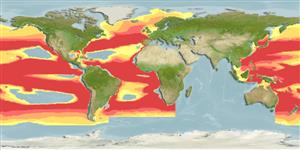Common names from other countries
Environment: milieu / climate zone / depth range / distribution range
Ecologia
marinhas batipelágico; intervalo de profundidade 0 - 2000 m (Ref. 86949). Deep-water
Tropical to temperate parts of all oceans.
Tamanho / Peso / Idade
Maturity: Lm ? range ? - ? cm
Max length : 10.5 cm SL (female)
Descrição suscinta
Chaves de identificação | Morfologia | Morfometria
Raios dorsais (total) : 5 - 7; Raios anais : 4 - 5. Metamorphosed females distinguished by the following characteristics: narrow snout, width of ethmoid cartilage and vomer considerably less than the distance between anterolateral tips of the lateral ethmoids and frontals; frontals short, lying posterior to the ethmoid region, dorsal margin convex; frontals separated from prootics; presence of vomerine teeth; large and nearly circular nasal foramina; presence of pterosphenoid; anterior end of illicial trough wider and shallower than the posterior end; well developed sphenotic spines; symphysial cartilage of upper jaw longer than wide; lower jaw with well developed symphysial spine; hyomandibula with double head; well developed quadrate spine, longer than articular spine; deeply notched posterior margin of opercle; long and narrow subopercle, dorsal end long and slender, tapering to a point, ventral end nearly circular; absence of first pharyngobranchial; well developed second pharyngobranchial; second hypobranchial articulates directlywith second basibranchial; caudal fin rays without internal pigmentation; illicium longer than length of escal bulb; pterygiophore of illicium cylindrical throughout length, emerging on snout from between frontal bones, anterior end exposed, posterior end concealed beneath skin; well developed first ray of dorsal fin; dorsal fin rays 5-7; anal fin rays 4-5; short and broad pectoral fin lobe, shorter than longest rays of pectoral fin; pectoral fin rays 16-19; coracoid lacking posteroventral process; simple pelvic bones, expanded distally; skin smooth and naked, without dermal spinules; darkly pigmented skin of caudal peduncle extends well past base of caudal fin (Ref. 86949).
Also mesopelagic (Ref. 10524).
Ciclo de vida ou comportamento de acasalamento
Maturities | Reprodução | Spawnings | Egg(s) | Fecundities | Larvas
Bertelsen, E., 1990. Oneirodidae. p. 498-507. In J.C. Quero, J.C. Hureau, C. Karrer, A. Post, and L. Saldanha (eds.) Check-list of the fishes of the eastern tropical Atlantic (CLOFETA). JNICT, Lisbon; SEI, Paris; and UNESCO, Paris. Vol. 1. (Ref. 10524)
Status na Lista Vermelha da UICN (Ref. 130435)
CITES (Ref. 128078)
Not Evaluated
Ameaça para os humanos
Harmless
Uso pelos humanos
Ferramentas
Relatórios especiais
Baixar XML
Fontes da internet
Estimates based on models
Preferred temperature (Ref.
115969): 1 - 13.3, mean 6.7 (based on 2192 cells).
Índice de diversidade filogenética (Ref.
82804): PD
50 = 1.0000 [Uniqueness, from 0.5 = low to 2.0 = high].
Bayesian length-weight: a=0.01995 (0.00906 - 0.04395), b=3.01 (2.83 - 3.19), in cm Total Length, based on all LWR estimates for this body shape (Ref.
93245).
Nível Trófico (Ref.
69278): 3.8 ±0.5 se; based on size and trophs of closest relatives
Resiliência (Ref.
120179): Elevada, tempo mínimo de duplicação da população menor que 15 meses (Preliminary K or Fecundity.).
Fishing Vulnerability (Ref.
59153): Low vulnerability (10 of 100).
